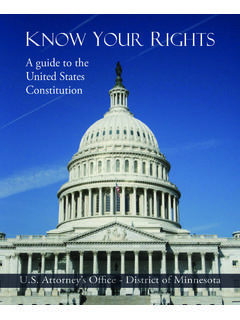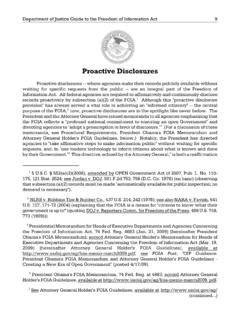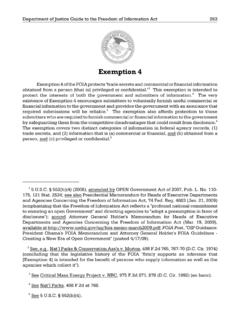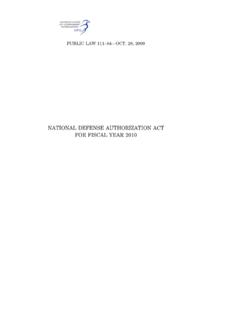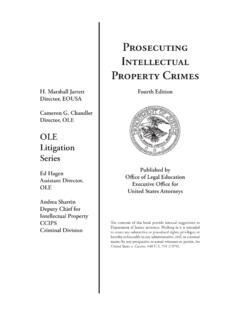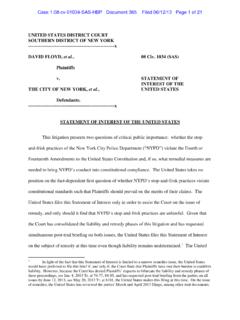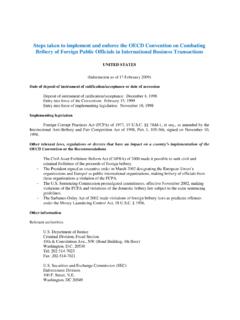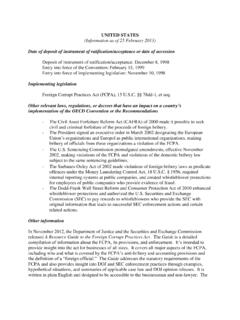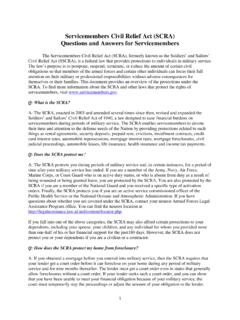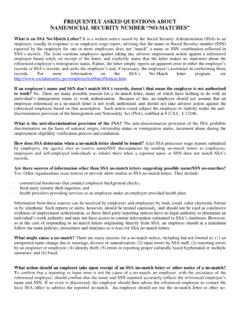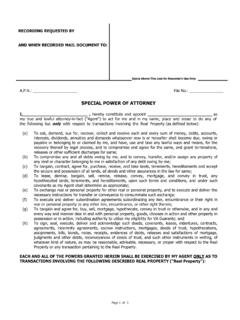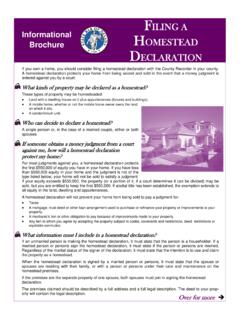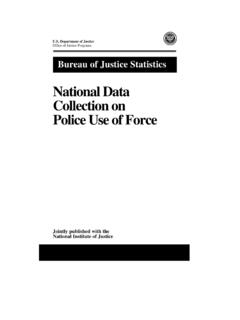Transcription of Home Confinement of Federal Prisoners After the COVID-19 ...
1 (Slip Opinion) 1 Home Confinement of Federal Prisoners After the COVID-19 Emergency The Coronavirus Aid, Relief, and Economic Security Act authorizes the Director of the Bureau of Prisons to place Prisoners in home Confinement only during the Act s cov-ered emergency period and when the Attorney General finds that the emergency condi-tions are materially affecting BOP s functioning. Should that period end, or should the Attorney General revoke the finding, the Bureau would be required to recall the pris-oners to correctional facilities unless they are otherwise eligible for home Confinement under 18 3624(c)(2). BOP s authority under 18 3621(a) and (b) does not provide an alternative basis for authorizing continued home Confinement for Prisoners ineligible for continuing home Confinement under section 3624(c)(2). January 15, 2021 MEMORANDUM OPINION FOR THE GENERAL COUNSEL Federal BUREAU OF PRISONS The Federal Bureau of Prisons ( BOP or the Bureau ) has statutory authority to place a prisoner serving a term in a Federal prison in home Confinement for the concluding portion of his sentence.
2 See 18 3624(c)(2). In connection with the COVID-19 pandemic, Congress expanded the authority of the Director of BOP to place Federal prison-ers in home Confinement earlier than that statutory period. See Corona-virus Aid, Relief, and Economic Security Act, Pub. L. No. 116-136, 12003(b)(2), 134 Stat. 281, 516 (2020) ( CARES Act ). The question is what happens to these Prisoners once the pandemic emergency ends. At that time, some inmates will have completed their sentences or be sufficiently close to the end to be eligible for home Confinement . Other inmates, however, may have a substantial time to go before becoming eligible. Although the pandemic emergency remains ongoing, the issue arises because BOP must plan for an eventuality where it might need to return a significant number of Prisoners to correctional facilities. We conclude that the CARES Act authorizes the Director of BOP to place Prisoners in home Confinement only during the statute s covered emergency period and when the Attorney General finds that the emer-gency conditions are materially affecting BOP s functioning.
3 See id. Should that period end, or should the Attorney General revoke the find-45 Op. __ (Jan. 15, 2021) 2 in g, the Bureau would be required to recall the Prisoners to correctional facilities unless they are otherwise eligible for home Confinement under 18 3624(c)(2). We also conclude that the general imprisonment authorities of 18 3621(a) and (b) do not supplement the CARES Act authority to authorize home Confinement under the Act beyond the limits of section 3624(c)(2). I. Section 3621(a) of title 18 of the United States Code instructs BOP to maintain custody of a person sentenced to a term of imprisonment until the expiration of the term imposed, or until earlier released for satisfacto-ry behavior pursuant to the provisions of section 3624. Section 3621(b) assigns BOP the responsibility of designat[ing] the place of the prison-er s imprisonment at a facility, subject to several considerations such as bed availability, the security designation of the prisoner, and proximity to the prisoner s residence.
4 Section 3621(b) also authorizes the Bureau at any time, subject to those same factors, to direct the transfer of a pris-oner from one penal or correctional facility to another. Section 3624(c) governs both home Confinement and other forms of what the statute calls prerelease custody lower-security conditions of Confinement that help prepare a prisoner for eventual release. Section 3624(c)(1) provides that BOP shall, to the extent practicable, ensure that a prisoner serving a term of imprisonment spends a portion of the final months of that term (not to exceed 12 months), under conditions that will afford that prisoner a reasonable opportunity to adjust to and prepare for the reentry of that prisoner into the community, such as a community correctional facility. Section 3624(c)(2) then states that BOP may use its prerelease custody authority to place a prisoner in home Confinement for the shorter of 10 percent of the term of imprisonment of that prisoner or 6 months.
5 Section 3624(c)(2) thus constrains BOP s Confinement authority by limiting a prisoner s time in home Confinement to no more than six of the final months of a prisoner s term. Recognizing that the COVID-19 pandemic was having a substantial effect on Federal correctional institutions, Congress in section 12003(b)(2) of the CARES Act expanded BOP s preexisting discretion to employ home Confinement . Section 12003(b)(2) provides that Home Confinement of Federal Prisoners After the COVID-19 Emergency 3 [d]uring the covered emergency period, if the Attorney General finds that emergency conditions will materially affect the function-ing of the Bureau, the Director of the Bureau may lengthen the maximum amount of time for which the Director is authorized to place a prisoner in home Confinement under the first sentence of section 3624(c)(2) of title 18, United States Code, as the Director determines appropriate.
6 The covered emergency period starts on the date on which the President declared a national emergency under the National Emergencies Act with respect to the Coronavirus Disease 2019 ( COVID-19 ) and ends on the date that is 30 days After the date on which the national emergen-cy declaration terminates. CARES Act 12003(a)(2), 134 Stat. at 516 (citation omitted). The President declared the COVID-19 pandemic a national emergen-cy on March 13, 2020, two weeks before the enactment of the CARES Act. See Declaring a National Emergency Concerning the Novel Coro-navirus Disease ( COVID-19 ) Outbreak, Proc. No. 9994, 85 Fed. Reg. 15,337 (Mar. 18, 2020). On April 3, 2020, the Attorney General found that COVID-19 emergency conditions were materially affecting the functioning of the Bureau of Prisons. Memorandum for the Director of the Bureau of Prisons from the Attorney General, Re: Increasing Use of Home Confinement at Institutions Most Affected by COVID-19 at 1 (Apr.)
7 3, 2020), ( Attorney General Memorandum ). You have advised us that following that determination, the BOP Direc-tor exercised his CARES Act authority by transferring thousands of Federal Prisoners into home Confinement . As of December 2020, BOP had transferred 18,112 inmates to home Confinement since enactment of the authority, out of a Federal prison population of approximately 150,000 inmates. See Statement of Michael D. Carvajal, Director, BOP, Before the Subcommittee on Crime, Terrorism, and Homeland Security, House Judiciary Committee 2, 6 (Dec. 2, 2020) ( Carvajal Testimony ). We understand that approximately 40 percent of those Prisoners would not have been eligible for such transfers absent the emergency 1 See E-mail for Jennifer Mascott & Conor Clarke, Office of Legal Counsel, from Kenneth P. Hyle, BOP, Re: Draft OLC Opinion on the CARES Act Home Confinement Authority (Jan.
8 14, 2021, 2:46 PM). 45 Op. __ (Jan. 15, 2021) 4 BOP has indicated that it will continue to conduct individualized assess-ments to make home Confinement placements for the duration of the pandemic. Id. at 6. These transfers have carried out the Attorney Gen-eral s instructions to, where possible, move vulnerable inmates with Centers for Disease Control-established COVID-19 risk factors out of institutions with significant infection rates, following a 14-day quarantine period to prevent transmission during transfer. Attorney General Memo-randum at 1 2. The question now is what will happen when BOP s emergency au-thority under section 12003(b)(2) of the CARES Act ends. That issue has important practical consequences because many of these thousands of Prisoners are currently in home Confinement earlier than section 3624(c)(2) would permit. You have explained that BOP has always had the discretion to return inmates to BOP facilities upon, or even prior to, the termination of the covered pandemic period.
9 But you have suggested th at BOP might continue home Confinement placements afterwards, on the theory that BOP properly exercised its authority to lengthen the maxi-mum amount of time for home Confinement during the emergency and that the consequences of those decisions might continue, even though the authority to make the decision in the first instance has lapsed. See Bureau of Prisons, Home Confinement Under the CARES Act at 2 (Nov. 20, 2020). We agree that the CARES Act does not alter BOP s discretion to return Prisoners to facilities either during the covered period or right when it ends. But once that authority expires, we believe that BOP must respect the time limits under section 3624(c)(2) for all Federal Prisoners , includ-ing those who had been transferred to home Confinement prior to the final months of their term under the special CARES Act placement authority.
10 II. Section 12003(b)(2) allows the Director, [d]uring the covered emer-gency period and based on a finding from the Attorney General, to lengthen the maximum amount of time for which [he] is authorized to place a prisoner in home Confinement . Once the Director s authority in section 12003(b)(2) expires, then so too does his authority to keep in-mates in home Confinement under this provision. Home Confinement of Federal Prisoners After the COVID-19 Emergency 5 Section 12003(b)(2) is the sole source of the Director s authori[ty] to lengthen the maximum amount of time that applies to the sentence of an inmate subject to home Confinement under the first sentence of section 3624(c)(2). Section 3624(c)(2), in turn, limits a term of home confine-ment to the shorter of 10 percent of the term of imprisonment of that prisoner or 6 months. In connection with the pandemic, Congress con-ferred upon the Director broad authority to disregard the ordinarily strict time limitations of section 3624(c)(2) in favor of any length that he de-termines appropriate.
